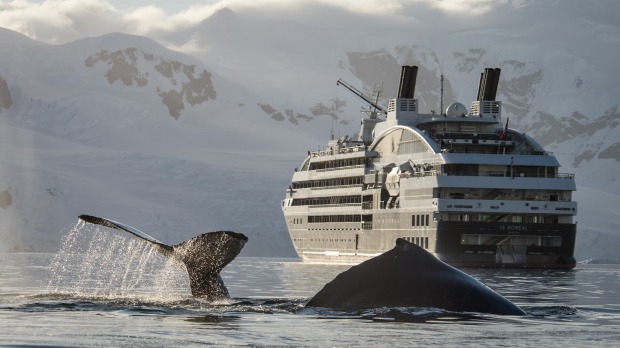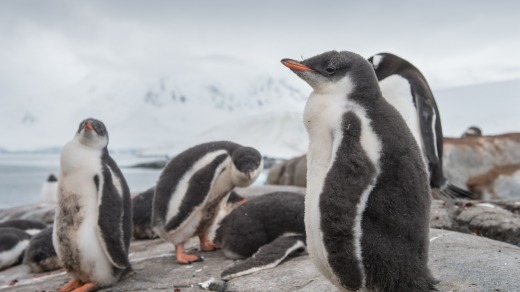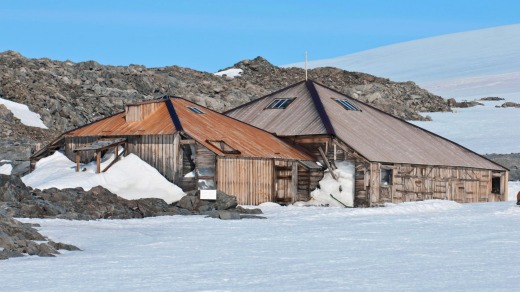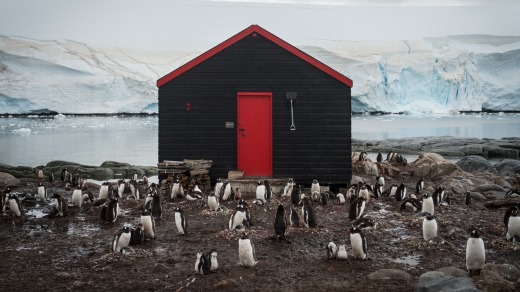
Can you carry big, heavy boxes over slippery rocks and slushy snow while dodging thousands of smelly penguins? Can you go without a shower for weeks? Can you get on with just three other people, from other countries, in confined quarters, for as much as five months?
Yes? Well, the United Kingdom Antarctic Heritage Trust has just the job for you in its post office at Port Lockroy, a pin-prick settlement clinging tenaciously to a rocky outcrop on Wiencke Island, at the southern end of the world, some 8000 kilometres from Port Jackson.
"Australians would get on here just fine," says base leader Sarah Auffret, who is also responsible for Port Lockroy's shop, museum and the long-term Gentoo penguin counting program.

"Of course, you miss home comforts at first, but this place really gets under your skin," Auffret concedes, cheerfully describing life in a Nissen hut, using buckets of water for toilets as "a sort of luxury camping, IKEA-style".
Despite its remoteness, there is no shortage of visitors, she explains. Her nearest neighbours, the Chilean navy, have a station only four kilometres away. The disputed, British Falkland Islands – called Las Malvinas on Argentinian maps – are 1500 kilometres away.
Whaler's Bay, on Deception Island is "one of the only places in the world where vessels can sail directly into the centre of a restless volcano''
And the summer months, when the island is effectively open for business, bring in thousands of cruise-ship visitors like us, anxious to send home postcards from the most isolated, the most picturesque, black-and-red post office/shop in the world.

The ships are very welcome, she says. Not only do they bring in revenue, needed to maintain heritage buildings throughout Antarctica, but they take away with them the station's cardboard, plastic and general waste.
It is day three of our Antarctic adventure, most of which has been spent enjoying the stunning scenery and the abundant wildlife: penguins, seals, whales and an assortment of seabirds: skuas, fulmars, petrels, kelp gulls and more.
Now we have pulled into Port Lockroy, which offers a wonderful opportunity to buy a few souvenirs, and get up close (though not too close) and friendly with the local penguins.

But more, it offers an insight into the life and times of those who have travelled these waters before us: not just tourists, but whalers, sealers, explorers and researchers, many of whom have left their mark on this, the highest, coldest, driest continent on the planet.
Port Lockroy – or "Base A, as it was prosaically designated by the British – was the first base to be established on the Antarctic Peninsula, in 1944. The original station hut, Bransfield House, has been carefully restored by the heritage trust.
As we discover, it is now a living museum, filled with displays of clothes, books, magazines, kitchen utensils, canned food, a short-wave radios, a gramophone; the minutiae of a life lived and, all too often lost, on the edge, in the extreme, at an outpost that once appeared beyond belief.
The displays showcase earlier attempts to survive in an environment blasted by ferocious "katabatic" – downslope, that is – winds of more than 160km/h, buried in snow, and cut off by sea ice for as much as six months of the year.
The good news for today's visitors, travelling on cruise ships and occasional yachts, in luxury conditions and high-tech clothes, and with communication devices unimagined by the early polar pioneers, is that Port Lockroy is just one of almost 100 historic sites and monuments in Antarctica.
They are recorded and protected by the Antarctic Treaty, an agreement that seeks to bind signatories, including Australia, to protect its pristine environment and, equally important, to keep the peace in an area of strategic and potentially economic significance.
These historic sites range in size and symbolism from a bust of the revolutionary Vladimir Illyich Lenin, erected by the Russians at the intriguingly titled Pole of Inaccessibility, to a rock cairn and plaque placed by Australian explorer Sir Douglas Mawson on Proclamation Island in 1930.
From a bust of one Captain Luis Alberto Pardo, on Elephant Island, in the South Shetland Islands, celebrating his part in the rescue of survivors from British explorer Ernest Shackleton's ill-fated trip on the Endurance, to a rock cairn at a spot named Walkabout Rocks, in the Vestfold Hills, Prince Elizabeth Island.
The cairn was erected in 1939 by Sir George Hubert Wilkins, the youngest of 13 children in a family of South Australian pioneer-settler farmers, and a remarkable man of many talents; pilot, soldier, geographer, ornithologist, movie photographer and, of course, explorer.
His name, and his Antarctic peregrinations – or should that be "penguinations"? – are now recalled in the names of a sound, a coast, an ice shelf and, more recently, a runway at Casey Station, in the Australian Antarctic Territory.
The list of Antarctic monuments also includes a memorial cross dedicated to the 257 people who died in the 1979 Mount Erebus disaster, when an aircraft crashed into the lower slopes of the mountain, located on Ross Island.
Many of these and other such landmarks may still be too remote, too out of reach, even for today's high-tech ships and their adventurous guests. Indeed, for a couple of hours, it was touch and go whether rough seas and high winds would make our long-awaited landing on Port Lockroy impossible.
Fortunately, the skies cleared, the seas flattened, and the port proved to be just a white-knuckle ride away on a bouncing, buzzing inflatable Zodiac. It was to be just one of several landings to explore fascinating historical sites and stations.
No sooner have we have emerged unscathed from the notoriously bumpy Drake Passage – by which most cruise ships access Antarctica from the mainland, Argentinian town of Ushuaia – than we seem to be travelling in the historic footprints of those who went before, in some cases two centuries ago.
Our first landing is on the crescent-shaped Half Moon Island, in the South Shetlands. Known to sealers from as early as 1821, It is now home to nesting chinstrap penguins (those with the "smiley" faces), a colony of blue-eyed cormorants and, for a few months, the Argentine Summer Research Station, Camara.
Not far away, according to the daily journal prepared by our on-board experts, a plaque commemorates the officers, soldiers and seamen of the Spanish vessel San Telmo, which sank here in September 1819. According to our historians, they were possibly the first people to live and die in Antarctica.
There is more, much more to see at our next stop, at Whalers Bay, on Deception Island. "It is," explains Rod Downie, environmental manager for the British Antarctic Survey, "one of the only places in the world where vessels can sail directly into the centre of a restless volcano".
It is a dramatic voyage for those on board our ship Le Boreal, which enters what is essentially a large, flooded caldera, through towering cliffs, on windswept seas, appropriately dubbed "Neptune's Bellows".
As recently as 2006, a Russian cruise ship, MV Lyubov Orlova ran aground on the island, and had to be towed off by a Spanish navy ice-breaker.
There are no such problems for Le Boreal. Within half an hour, it is safely parked, and an armada of inflatable Zodiacs is scudding across the calm sea, carrying our first group of "explorers" ashore at Whalers Bay.
Hereabouts, in 1967, volcanic eruptions destroyed a Chilean base. Two years later more eruptions badly damaged a British base, burying much of the old whaling station in ash and cinders. And a third eruption in 1970 produced a series of craters, which are still visible.
Fortunately, for the time being at least, there are still plenty of relics to be seen of a whaling industry established at what is now known as Port Foster in the early 1900s: whale bones; the skeletons of old Norwegian whaling boats; a long, uneven line of rickety huts; huge, rusting retorts and assorted pipework used in the production of whale oil; an "off limits" aircraft hangar.
With a look in an illustrated history book, and a leap of imagination, it is not difficult to conjure up visions of olden days when the bay was crowded with large, ocean-going ships crawling with men "flensing", removing the blubber from captured whales.
"How ironic, how splendid," an Australian visitor exclaims, "that a century later we should all love and protect the whales, and spend thousands of dollars coming to Antarctica to see them."
Elsewhere on the Whalers Bay site there is a further reminder of the risks taken by the early Antarctic pioneers, whether their goals were commercial or scientific: a cemetery with 35 burials, and a memorial to a further ten men lost at sea.
For a sense of how such men lived, what they ate, why they were there, how they survived, as recently as the 1950s and '60s, our next stop, Port Lockroy, is an invaluable showcase. A picturesque stop. A revealing storehouse of motives and memories.
Typically, perhaps, Port Lockroy was established by the British towards the end of World War II during Operation Tabarin, a search for bases prompted by concerns over German, Japanese and American ambitions in the area, and the rising price of Argentine beef!
Not that beef appears to have been on the menu much. As a quick browse through the base library suggests, Port Lockroy cooks were more likely to serve local seafood. A recipe on show in the museum describes how to secure and cook juicy seal brains on toast.
Simple. Just add four penguin eggs, two ounces of butter, some chopped tomato, pepper, salt and mixed herbs and serve on toast. Mmm.
Moving on, we come the next day to Detaille Island, another British survey base used for geological and meteorological research until the late 1950s, when it was evacuated after becoming inaccessible due to gathering, unstable sea-ice. Despite the assistance of a couple of American ice-breakers, the Britons' re-supply ship, Biscoe, was not able to get closer than 50 kilometres from the base. Hurriedly, the men were forced to pile valuable gear, scientific records and a few personal belongings on to sleds, and use dog teams to reach their helpers.
The official Antarctic Treaty description is of a site consisting of "a hut and a range of associated structures and outbuildings including a small emergency storage building, bitch and pup pens, anemometer tower and two standard tubular steel radio masts".
In fact, so hasty was the abandonment of "Base W" – as it was dubbed by the unimaginative British – that it survives as a time capsule containing wonderful, nostalgic artefacts.
They include cans of Scotch porridge oats, bottles of Heinz mayonnaise, cupboards of empty bottles of gin and whisky, jackets and longjohns, and a Hoover washing machine, complete with operating instructions.
In marked contrast to "Base W", our final "heritage and history hit" – on a grand Antarctic Tour, much of which was, of course, dedicated to penguins and seals, whales and birds, icebergs and snow fields – rates low on memorabilia, high in unimaginably beautiful scenery.
Old, black-and-white photographs of Neko Harbour in the early 1900s show the landing area blackened by oil, blenched with smoke from floating whale factory ships, such as the 3576-ton, Norwegian Neko, after which the bay was eventually named.
Whalebones may still be found along the cobble beach, which leads past the Gentoo penguin colony to the site of a refuge established by the Argentinians but apparently destroyed in 2009. There is also a survey marker on a near-by rocky outcrop.
But today, our guide explains, visitors come to Neko Bay in their thousands each year, primarily for the spectacular snow cape, the climb, the views.
Steep, and slushily slippery in places, the track takes them up through the towering glaciers, across crevassed slopes, above the "calving" icebergs, which disconcertingly collapse in huge chunks into the sea below, creating dangerous "mini-tsunamis".
Looking out across the harbour, blazing blue in the afternoon sun, our guide explains that for the first time on our trip, we are standing on the Antarctica mainland. From here it is possible to walk to the South Pole. "It's only … what? A few thousand kilometres."
Good news! Cruise ships and their guests are also welcome to visit Australia's prime piece of Antarctic heritage: the huts at Cape Denison used by Sir Douglas Mawson and his party on the Australasian Antarctic Expedition in 1911-14.
"Access to the public is important if we are to raise awareness of the significance of the historic expedition and funds for conservation of the huts," says David Jensen, chairman of the Mawson's Huts Foundation.
Bad news! Entry by ship to the site via Commonwealth Bay, George V Land, has been blocked for the last two summer seasons by a giant iceberg, numbered B90B, estimated to measure 140 kilometres long and 50 kilometres wide.
Encouraged by long-term water temperature trends and suggestions that the monster may have been "nudged out of the way" by another iceberg, Jensen is hopeful access will be re-opened for the next cruise season.
Already, one cruise ship has announced plans to visit the three huts, which are so far to the east that they are reached not from the Argentinian port of Ushuaia but Hobart, Tasmania.
The centrepiece of the site is the winter living quarters, known as "Mawson's Hut", a pyramid-roofed building which was home to as many as 18 men of the main base party.
According to the Australia Department of the Environment's citation, "Sir Douglas Mawson's incredible spirit and courage is epitomised in the huts still standing today in the hostile environment of Antarctica."
They captured the nation's imagination. "Even the world's most ferocious winds and coldest temperatures, formidable mountains and crevasses could not destroy them."
During their stay, Mawson's team studied the weather, geology and magnetics, and pioneered the use of wireless communication on the Antarctic continent.
"They battled intense winds, icy conditions and long periods of isolation to gather this material."
Meanwhile, for those people who cannot wait – or, perhaps, afford – to travel to Cape Denison to see the real things, the North Sydney-based foundation has financed and built a full-size replica of Mawson's Huts on the waterfront in Hobart.
Heritage carpenters even used Baltic pine sourced from the same Scandinavian sawmill that supplied timber to Mawson's expedition, which was sponsored in part by The Sydney Morning Herald.
Since its opening on December 2, 2013 – the 102nd anniversary of Mawson's departure to Antarctica – the museum has attracted more than 30,000 visitors.
Scenictours.com.au
Scenic's Antarctic cruises start and finish in Buenos Aires, though the ships start from Ushuaia, on the southern-most tip of Argentina. LAN and Qantas are among carriers offering connection options from Australia.
The Scenic Tours' "Ultimate Antarctica Cruise" explores the icy peninsula, visiting Port Lockroy, Deception Island, Crystal Sound and other attractions by inflatable Zodiacs – depending on sea conditions – over 10 luxury nights. There are three departure dates in the next, 2016, season: February 3, 13 and 17. The price is $12,895 a person, twin share. International flights are not included.
The writer travelled as a guest of Scenic Tours.